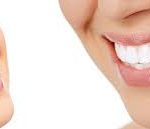
Look into the mirror and smile wide :-))
Do you like your smile? Are you comfortable with the color, shape as well as with the position of your teeth? If yes – great! If not, it’s okay. Most of your dislikes and problems could be solved thanks to modern dental materials and the latest technologies in cosmetic dentistry.
By the way, the “Hollywood smiles” – as we know it today were not made at the movie studios, but in the dental chair. Many technologies such as veneers that are popular today, were originally invented specifically for the cinema. Later they were improved and began to be used in everyday life.
Lack of teeth and removable dentures are not an obligatory attribute of old age at all. In the USA and Europe, for example, dentists have set the task of preserving at least 20 “native” teeth to 70-year-old patients with the help of preventive programs. Fortunately, modern technologies allow not only high-quality treatment of teeth but also rejuvenation, restoring their beauty and strength. Cosmetic or aesthetic dentistry does this.
What is the difference between aesthetic restoration and common filling? When filling a carious cavity, restoration of tooth function is of paramount importance. Those. so that a sealed tooth can chew food qualitatively. The appearance of the seal thus goes by the wayside. A tooth restored taking into account individual characteristics is practically indistinguishable from natural. When restoring a tooth, the doctor models tubercles, fissures (indentations), with special “paints” you can simulate the “strokes” characteristic of a given tooth.
When restoring the front teeth from the filling material, it requires a variety of shades and a good polish. It is necessary to transmit the brilliance of the restoration, similar to that of natural teeth. Usually, a set of filling material includes a few containers with composites, they are of different color and transparency using them in the right proportion you can restore the tooth in such a way that in shape, color and transparency it will be as close to natural as it can be possible .
An alternative to tooth restoration using filling materials is the use of micro prostheses – i.e. tabs and veneers. This is a higher and more technologically advanced level of tooth restoration. The tab is a “seal” made of a ceramic or composite made by a laboratory method. Veneer is a “patch” on the front surface of the tooth (usually the frontal group), which can also be ceramic or composite. The advantage of this technology is that the laboratory method of manufacturing a microprosthesis allows you to satisfy the highest requirements for restoring the anatomical shape and aesthetic characteristics of the restorations.
No matter how good the filling materials are, it’s impossible to restore a tooth that has been destroyed badly enough. If only the root is left from the tooth, then no, even the best, seal can fix the situation. In this case, the tooth must be prosthetized. To avoid this outcome, you must regularly visit the painless dentist in our dental clinic for preventive purposes. Tooth restoration using inlays and veneers is more difficult work than filling a tooth.
For the manufacture of a micro prosthesis, as a rule, two visits to the dentist are required. At the first visit, the tooth is prepared – i.e. in a certain way is “ground”. Then, casts are taken from the dentition of both jaws. Then in the dental laboratory, the dental technician makes a micro prosthesis. In the second visit, the microprosthesis is fixed to the tooth. Given the complexity of microprosthetics technology, the cost of such work is significantly higher than the cost of the seal. But such restoration serves much longer than even the best seal.
Cosmetic dentist Dr Anne Gershkowitz, in Staten Island NY and NJ use the technology of almost all dental disciplines. She was given the opportunity to solve problems such as:
- correction of incorrect position of teeth;
- bite correction;
- masking the gap between the teeth, which often increases with age (diastema);
- removal of gaps between teeth;
- teeth whitening;
- teeth lining to help improve their color and shape.
The main concern of cosmetic dentistry is to make your teeth beautiful. What makes a smile beautiful? First of all the shape of individual teeth, as well as the proportionality of the dentition as a whole, symmetry, position in the arch of a single tooth or groups of teeth. Naturally, the attractiveness of your smile is also associated with the color of the teeth, the texture of their surface.









